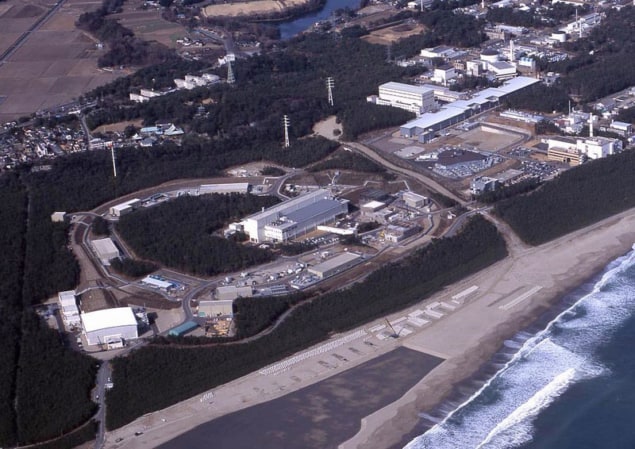
Physicists in Japan are assessing the state of the country’s research facilities in the aftermath of Friday’s major earthquake and tsunami. The 8.9 magnitude (on the Richter scale) earthquake, with an epicentre around 130 km off the eastern coast of Japan, has wrought untold devastation on the country’s eastern coastline. As the clean-up begins, scientists are now beginning to evaluate how much damage has been caused to the country’s research infrastructure and facilities.
Currently the massive new $1.5bn Japan Proton Accelerator Research Complex (J-PARC), which opened two years ago, remains closed and will stay shut for at least another three days while safety inspections are carried out. Lying on the eastern coast of Japan around 200 km south of Sendai – one of the worst hit areas of the quake – the facility currently has electricity but is without running water. J-PARC produces a range of particles including neutrons, muons, kaons and neutrinos from three accelerators: a 200 MeV linear accelerator; a 3 GeV proton synchrotron; and a 50 GeV proton synchrotron.
According to J-PARC director Shoji Nagamiya the lab has, however, been unaffected by the tsunami because the facility was built with enough defences to withstand a 10 m wave. “Fortunately, no-one from J-PARC has had any injuries,” says Nagamiya. “There are also no radiation problems.”
Fortunately, no-one from J-PARC has had any injuries, there are also no radiation problems J-PARC director Shoji Nagamiya
A preliminary inspection from researchers who battled for hours to reach the facility on Sunday also revealed that the earthquake has done little damage to buildings at J-PARC thanks to strict building codes. However, roads around the facility have been severely damaged with cracks as big as 50 cm wide. Nagamiya says he is unsure how long it will take before the facility is fully back up and running again.
Masatoshi Arai, deputy director of the Materials Life Facility (MLF) at J-PARC, which operates the facility’s neutron spallation source, adds that no MLF personnel have been harmed during the earthquake. However, he says that the mercury target used to produce neutrons has moved around 30 cm and that although the extent of the damage is not yet known, it could take more than six months for the MLF to return to normal.
Delayed results
Meanwhile, the Tokai to Kamioka (T2K) experiment, which involves generating neutrinos at J-PARC’s 30 GeV proton synchrotron and sending them to the vast SuperKamiokande detector that lies 300 km away in an underground mine in the city of Hida, also seems to have remained unscathed. David Wark, from Imperial College London and former international co-spokesperson of T2K, told physicsworld.com that the experiment was running at the time of the earthquake, but was shut down immediately and has not restarted since.
“The condition of the experiment and accelerators is unknown,” he says. “There is some superficial damage to the buildings and some damage to roads and services caused by ground failure. However, the major facilities are supported by pillars reaching the bedrock so hopefully subsidence will be less.” Researchers have not yet entered any of the buildings, so cannot currently assess any damage to experiments.
Wark says the earthquake struck last Friday just a few minutes before T2K researchers were going to present their first results from the facility. Those results will now be revealed on Wednesday at a neutrino telescopes conference in Venice.
Meanwhile, the KEK high-energy physics lab, which lies around 50 km north-east of Tokyo in Tsukuba, has established an earthquake emergency response team. Led by Atsuto Suzuki, director general of KEK, the team will start an investigation of the facilities this week. In a statement the lab says there has been some damage to the buildings and facilities, although there are no reports of casualties at the site.
Elsewhere in Japan, Hitoshi Murayama, director of the Institute for the Physics and Mathematics of the Universe (IPMU), which is based at the University of Tokyo, says there has been no damage to the university’s campus or the IPMU’s building. Murayama, is however, concerned for researchers at Tohoku University in Sendai, which lies around 10 km inland from the coast. “While I was told there has been no collapse of buildings, the lack of power, water and gas, and shortage of food is becoming serious.”
Finally, three researchers from J-PARC are among those to have been sent to the Fukushima reactor to undertake radioactivity surveys. Since Friday’s earthquake there have been two explosions at the facility where engineers are pumping seawater into the reactor to stop a potential meltdown of the nuclear fuel.
If you are a physicist working in the region with any information about how your institute or university has been affected by the earthquake then please contact michael.banks@iop.org
Update: 14:00 GMT 15 March. In an e-mail to members of the Japanese Physical Society (JPS), Miyanaga Masaharu, JPS chairman, says that the society’s board has decided to cancel its annual meeting. The conference was to be held at Niigata University on 25–28 March. More details will be posted on the JPS website on 18 March.
Update: 16:20 GMT 15 March. The Japan Society of Applied Physics (JSAP) has also cancelled its spring meeting, according to Tatsuzo Dazai, publishing and business-development director at the JSAP and the JPS. The meeting was due to have taken place at the Kanagawa Institute of Technology in Atsugi, Kanagawa Prefecture, on 24–27 March.
Update: 08:50 GMT 16 March. Soichi Wakatsuki, director of the Photon Factory – a national synchrotron radiation facility based at the KEK particle-physics lab – wrote in an e-mail that the facility’s linear accelerator has suffered “substantial damages”, including the displacement of three radio frequency modules by about 10 cm and one magnet that fell onto the floor. Wakatsuki says engineers will need to turn the facility back on before knowing the true extent of the damage and it will be “at least two to three months” before the facility is back to normal again.



